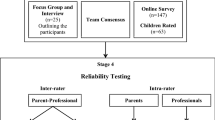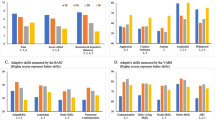Abstract
This study examined the construct validity of the Autism Classification System of Functioning: Social Communication (ACSF). Participants included 145 parents of children with autism (2–19 years). The degree of convergent and discriminant validity between parent reported ACSF and subscales from Social Responsiveness Scale 2nd edition and Behavior Assessment System for Children, 3rd Edition were examined against a priori hypotheses. We examined construct validity in the entire sample as well as in specific age cohorts. Our findings suggest that ACSF can provide a valid classification system of social communication ability in children with autism 2–19 years of age, and its two subscales may be used to examine different aspects of social communication ability.

Similar content being viewed by others
References
Adrien, J. L., Lenoir, P., Martineau, J., Perrot, A., Hameury, L., Larmande, C., & Sauvage, D. (1993). Blind ratings of early symptoms of autism based upon family home movies. Journal of the American Academy of Child & Adolescent Psychiatry, 32(3), 617–626
APA. (2013). Diagnostic and Statistical Manual of Mental Disorders. Fifth). American Psychological Association
Ariel Cascio, M. (2012). Neurodiversity: 0utism pride among mothers of children with autism spectrum disorders. Intellectual and Developmental Disabilities, 50(3), 273–283. https://doi.org/10.1352/1934-9556-50.3.273
Association, A. P. (2013). Diagnostic and Statistical Manual of Mental Disorders
Baldwin, D. (1995). Joint attention: Its origin and role in development. In Understanding the link between joint attention and language (pp. 131–158)
Bauminger, N., Shulman, C., & Agam, G. (2003). Peer Interaction and Loneliness in High-Functioning Children with Autism. Journal of Autism and Developmental Disorders, 33(5), 489–507. https://doi.org/10.1023/A:1025827427901
Braun, M. J., Dunn, W., Tomchek, S. D., Carlson, G., Armitstead, C., Rodger, S. … Robbins, T. W. (2017). A pilot study on professional documentation: Do we write from a strengths perspective? American Journal of Speech-Language Pathology, 26(2), 972–981. https://doi.org/10.1044/2017_AJSLP-16-0117
Bruni, T. P. (2014). Test Review: Social Responsiveness Scale–Second Edition (SRS-2). Journal of Psychoeducational Assessment, 32(4), 365–369. https://doi.org/10.1177/0734282913517525
Centers for Disease Control and Prevention. (2018). Prevalence of autism spectrum disorder among children aged 8 years—autism and developmental disabilities monitoring network, 11 sites, United States 2014. Morb Mort Wkly Rep Surv Summ, 67, 1–23
Charman, T. (2003). Why is joint attention a pivotal skill in autism? Philosophical Transactions of the Royal Society B: Biological Sciences, 358(1430), 315–324. https://doi.org/10.1098/rstb.2002.1199
Cohen, J. (1988). Statistical power analysis for the behavioral sciences. Lawrence Erlbaum Associates
Constantino, J., & Gruber, C. (2005). Social responsiveness scale. Western Psychological Services
Constantino, J. N., & Gruber, C. P. (2012). Social responsiveness scale–second edition (SRS-2). Western Psychological Services
Corbett, B. A., Schupp, C. W., & Lanni, K. E. (2012). Comparing biobehavioral profiles across two social stress paradigms in children with and without autism spectrum disorders. Molecular Autism, 3(1), 1–10. https://doi.org/10.1186/2040-2392-3-13
Craig, F., Crippa, A., Ruggiero, M., Rizzato, V., Russo, L., Fanizza, I., & Trabacca, A. (2021). Characterization of Autism Spectrum Disorder (ASD) subtypes based on the relationship between motor skills and social communication abilities.Human Movement Science, 77(102802)
Craig, F., Fanizza, I., Russo, L., Lucarelli, E., Lorenzo, A., Pasca, M. G., & Trabacca, A. (2017). Social communication in children with autism spectrum disorder (ASD): Correlation between DSM-5 and Autism Classification System of Functioning—Social Communication (ACSF:SC). Autism Research, 10(7), 1249–1258. https://doi.org/10.1002/aur.1772
Cronbach, L. J., and P. E (1955). Construct validity in psychological tests. Psychological Bulletin, 52(4), 281. https://doi.org/10.4324/9781315128498
Di Rezze, B., Gentles, S. J., Hidecker, M. J., Zwaigenbaum, L., Rosenbaum, P. R., Duku, E. … Viveiros, H. (Under Review). Adaptation and reliability of the Autism Classification System of Functioning for social communication: from toddlerhood to adolescent-aged children with autism.Journal of Autism and Developmental Disorders
Di Rezze, B., Rosenbaum, P., Zwaigenbaum, L., Hidecker, M. J. C., Stratford, P., Cousins, M. … Law, M. (2016). Developing a classification system of social communication functioning of preschool children with autism spectrum disorder. Developmental Medicine and Child Neurology, 58(9), 942–948. https://doi.org/10.1111/dmcn.13152
Education, P. (2016). BASC-3 scales, composites and indexes for the TRS, PRS, and SRP
Fein, E. (2015). “No one has to be your friend”: Asperger’s syndrome and the vicious cycle of social disorder in late modern identity markets. Ethos, 43(1), 82–107. https://doi.org/10.1111/etho.12073
Fuller, E. A., & Kaiser, A. P. (2020). analysis. 50(5), 1683–1700. https://doi.org/10.1007/s10803-019-03927-z.The
Gentles, S. J., Nicholas, D. B., Jack, S. M., McKibbon, K. A., & Szatmari, P. (2020). Coming to understand the child has autism: A process illustrating parents’ evolving readiness for engaging in care. Autism, 24(2), 470–483. https://doi.org/10.1177/1362361319874647
Georgiades, S., & Kasari, C. (2018). Reframing optimal outcomes in autism. JAMA Pediatrics, 172(8), 716–717
Kim, H. Y. (2013). Statistical notes for clinical researchers: assessing normal distribution (2) using skewness and kurtosis. Restorative Dentistry & Endodontics, 38(1), 52. https://doi.org/10.5395/rde.2013.38.1.52
Lord, C., & MaGill-Evans, J. (1995). Peer interactions of autistic children and adolescents. Development and Psychopathology, 7(4), 611–626
Morales, M., Mundy, P., Delgado, C. E. F., Yale, M., Messinger, D., Neal, R., & Schwartz, H. K. (2000). Responding to Joint Attention Across the 6- Through 24-Month Age Period and Early Language Acquisition. Journal of Applied Developmental Psychology, 21(3), 283–298. https://doi.org/10.1016/S0193-3973(99)00040-4
Ofner, M., Coles, A., Decou, M. L., Do, M., Bienek, A., Snider, J., & Ugnat, A. (2018). Autism Spectrum Disorder Among Children and Youth in Canada 2018: A report of the National Autism Spectrum Disorder Surveillance System
Orsmond, G. I., Krauss, M. W., & Seltzer, M. M. (2004). Peer relationships and social and recreational activities among adolescents and adults with autism. Journal of Autism and Developmental Disorders, 34(3), 245–256. https://doi.org/10.1023/B:JADD.0000029547.96610.df
Osterling, J. A., Dawson, G., & Munson, J. A. (2002). Early recognition of 1-year-old infants with autism spectrum disorder versus mental retardation. Development and Psychopathology, 14(2), 239–251. https://doi.org/10.1017/S0954579402002031
Pierce, K., Gazestani, V. H., Bacon, E., Barnes, C. C., Cha, D., Nalabolu, S. … Courchesne, E. (2019). Evaluation of the Diagnostic Stability of the Early Autism Spectrum Disorder Phenotype in the General Population Starting at 12 Months. JAMA Pediatrics, 173(6), 578–587. https://doi.org/10.1001/jamapediatrics.2019.0624
Reynolds, C. R., & Kamphaus, R. W. (2015). Behavior Assessment System for Children – Third Edition. NCS Pearson, Inc
Richardson, J. T. E. (2011). Eta squared and partial eta squared as measures of effect size in educational research. Educational Research Review, 6(2), 135–147. https://doi.org/10.1016/j.edurev.2010.12.001
Steiner, A. M. (2011). A strength-based approach to parent education for children with autism. Journal of Positive Behavior Interventions, 13(3), 178–190. https://doi.org/10.1177/1098300710384134
Stevens, S. S. (1946). On the Theory of Scales of Measurement Author (s): S. S. Stevens. Science, 103(2684), 677–680
Sullivan, L., Mastergeorge, A., & Mundy, P. (2015). A Look at Joint Attention in Preschool Children: Why is it meaningful to measure and what is the best methodology for measurement? International Journal of School and Cognitive Psychology, 2(120), 2
Sutton, B. M., Webster, A. A., & Westerveld, M. F. (2019). A systematic review of school-based interventions targeting social communication behaviors for students with autism. Autism: The International Journal of Research & Practice, 23(2), 274–286. https://doi.org/10.1177/1362361317753564
Taheri, A., & Perry, A. (2012). Exploring the proposed DSM-5 criteria in a clinical sample. Journal of Autism and Developmental Disorders, 42(9), 1810–1817. https://doi.org/10.1007/s10803-012-1599-4
Tajik-Parvinchi, D., Hidecker, M. J. C., Selvakumaran, S., Fan, L., Batth, S., Fang, H. … Di Rezze, B. (2021). Operationalizing Social Communication in Autism and Related Neurodevelopmental Research: a Scoping Review Over 20 Years. Current Developmental Disorders Reports. https://doi.org/10.1007/s40474-021-00224-2
Taylor, L. J., Charman, T., Howlin, P., Slonims, V., & Green, J. (2020). Brief Report: Associations Between Preverbal Social Communication Skills, Language and Symptom Severity in Children with Autism: An Investigation Using the Early Sociocognitive Battery. Journal of Autism and Developmental Disorders, 50(4), 1434–1442. https://doi.org/10.1007/s10803-020-04364-z
Terwee, C. B., Bot, S. D. M., de Boer, M. R., van der Windt, D. A. W. M., Knol, D. L., Dekker, J. … de Vet, H. C. W. (2007). Quality criteria were proposed for measurement properties of health status questionnaires. Journal of Clinical Epidemiology, 60(1), 34–42. https://doi.org/10.1016/j.jclinepi.2006.03.012
Toth, K., Munson, J., Meltzoff, A. N., & Dawson, G. (2006). Early predictors of communication development in young children with autism spectrum disorder: Joint attention, imitation, and toy play. Journal of Autism and Developmental Disorders, 36(8), 993–1005. https://doi.org/10.1007/s10803-006-0137-7
Westby, C., & Washington, K. N. (2017). Using the international classification of functioning, disability and health in assessment and intervention of school- aged children with language impairments. Language, Speech, and Hearing Services in Schools, 48(3), 137–152. https://doi.org/10.1044/2017_LSHSS-16-0037
World Health Organization (2001). Towards a common language for functioning, disability, and health: ICF.
Acknowledgements
Funding support was provided by the Hamilton Health Sciences New Investigator Fund 2019 (to BDR), Hamilton Health Sciences Early Career Award 2018–2020 (to BDR), and Hamilton Academic Health Sciences Organization 2018–2020 (to PR and BDR).
Author information
Authors and Affiliations
Corresponding author
Additional information
Publisher’s note
Springer Nature remains neutral with regard to jurisdictional claims in published maps and institutional affiliations.
Rights and permissions
About this article
Cite this article
Tajik-Parvinchi, D., Rosenbaum, P., Hidecker, M.J.C. et al. Construct Validity of the Autism Classification System of Functioning: Social Communication (ACSF:SC) Across Childhood and Adolescence. J Autism Dev Disord 53, 3246–3256 (2023). https://doi.org/10.1007/s10803-022-05608-w
Accepted:
Published:
Issue Date:
DOI: https://doi.org/10.1007/s10803-022-05608-w




